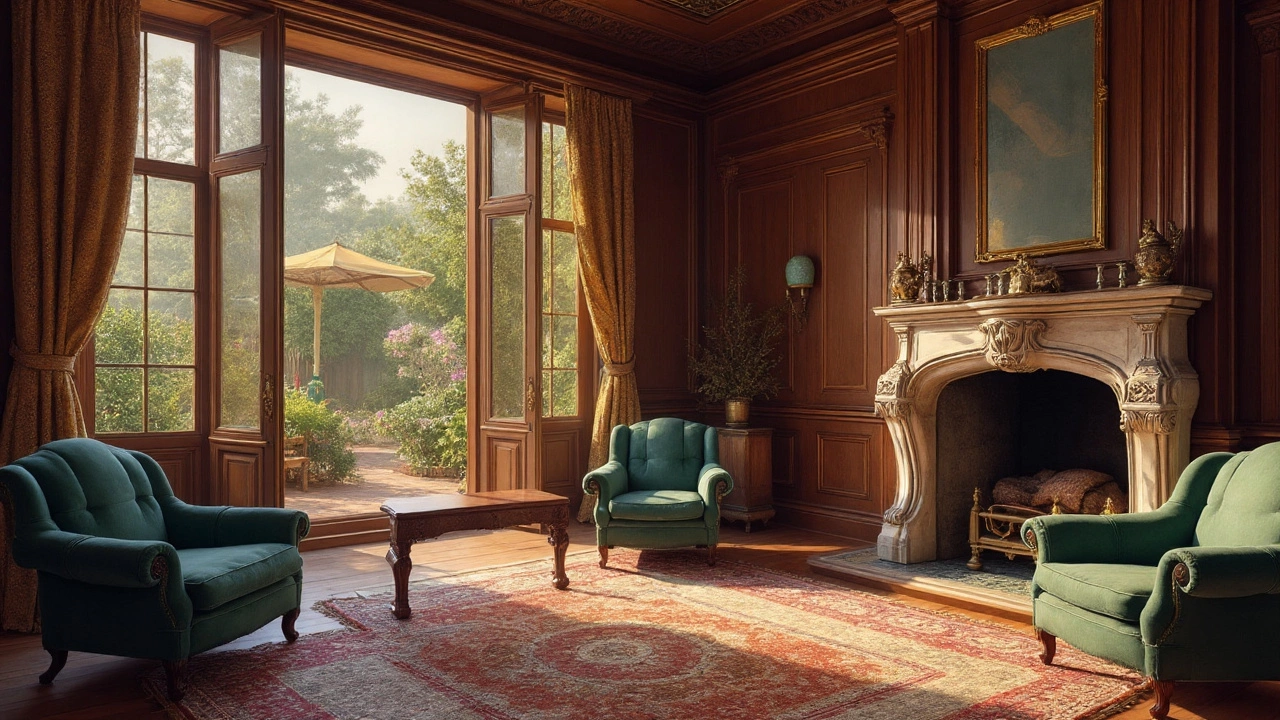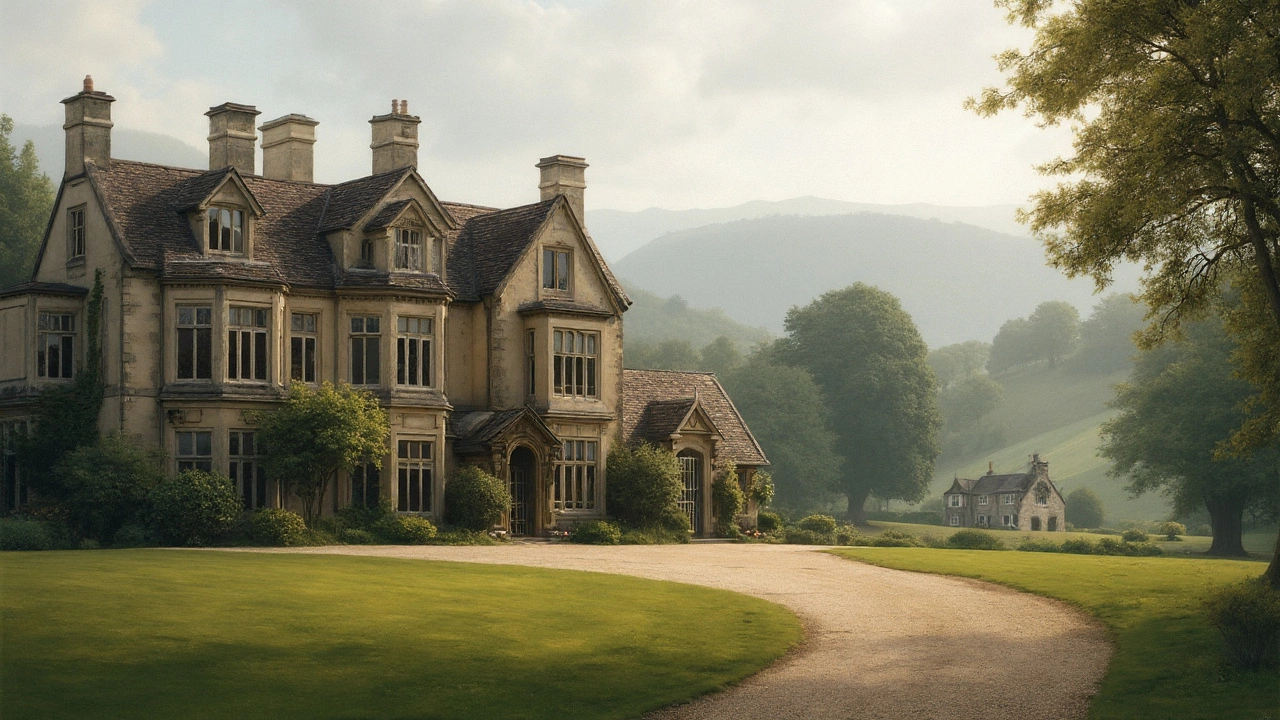Country House Identification Quiz
1. What is the typical size range of a country house?
2. Which architectural style is most commonly associated with English country houses?
3. What is the primary contemporary use of a country house?
4. Which property type is most likely to be GradeI listed?
5. Which feature best distinguishes a country house from a cottage?
Country house is a residential building located in a rural setting, typically owned by a wealthy family or gentry. It serves as a seasonal retreat, a venue for entertaining, and often functions as the administrative hub of a surrounding estate. Characterized by spacious rooms, formal gardens, and distinct architectural styles such as Georgian or Tudor, a country house blends leisure with a touch of prestige.
Historical Roots of the Country House
The concept emerged in England during the 16th‑century rise of the landed gentry. Early examples, like Hardwick Hall, showcased elaborate stone façades and extensive parklands. By the Victorian era, the Country house hotel model appeared, converting private homes into accommodation for travelers seeking countryside charm.
Key Architectural Features
- Multiple reception rooms - drawing‑room, library, ballroom.
- Symmetrical façades, often with sash windows.
- Manicured gardens, sometimes formal hedges or water features.
- Service wings or separate outbuildings for staff.
These elements differentiate a country house from a simple cottage, which usually offers a modest footprint, rustic materials, and limited formal spaces.
How It Differs From Similar Property Types
| Property Type | Typical Size (sqft) | Dominant Architectural Style | Primary Use |
|---|---|---|---|
| Country house | 5,000-20,000 | Georgian, Tudor, Palladian | Seasonal residence & entertaining |
| Manor | 10,000-30,000 | Medieval, Elizabethan | Estate administration & status symbol |
| Villa | 3,000-15,000 | Renaissance, Mediterranean | Luxury leisure home |
| Cottage | 500-2,500 | Thatched, Vernacular | Permanent modest dwelling |
| Farmhouse | 1,500-5,000 | Functional, Brick or Timber | Residential core of an agricultural operation |
Typical Location and Land Use
A country house usually sits on several acres of landscaped parkland, often adjacent to woodlands, lakes, or rolling hills. The surrounding land can be a heritage estate protected for its historic value, or a modern rural retreat that offers privacy and scenic views. By contrast, a farmhouse is tied directly to productive farmland and outbuildings like barns.
Ownership and Social Context
Historically, country houses were owned by the aristocracy or emerging industrial magnates. Records from the 19th‑century British Land Registry show that over 2,500 such properties changed hands during the Industrial Revolution, reflecting newfound wealth. Today, owners range from private families to investors who convert them into country house hotels or event venues. The shift has altered the social function: from private power base to public cultural attraction.

Preservation and Legal Status
Many country houses are listed under national heritage schemes. In England, a Grade I listed building denotes exceptional interest, covering only 2.5% of all listed structures. This status imposes strict guidelines on renovation, ensuring the original stonework, roof tiles, and interior plasterwork remain intact. Owners of heritage property often receive grants for restoration, but must balance modern comforts with preservation rules.
Related Concepts and Extensions
Understanding a country house opens the door to several adjacent topics:
- Landscape gardening - the art of shaping the surrounding grounds. \n
- Estate management - overseeing agriculture, forestry, and tenant relations.
- Adaptive reuse - converting historic homes into hotels, museums, or event spaces.
Buying or Restoring a Country House: Practical Tips
- Check the property’s listing status. A Grade II or higher listing may affect renovation budgets.
- Assess the condition of core elements - roof, foundations, and original masonry. Historic surveys often reveal hidden structural issues.
- Plan for modern amenities (heating, plumbing, internet) while respecting heritage guidelines.
- Engage a specialist conservation architect early in the process.
- Explore potential revenue streams: boutique hotel, wedding venue, or exclusive holiday rentals.
Country House vs. Country Cottage: Quick Checklist
- Size: houses are generally over 5,000sqft; cottages stay under 2,500sqft.
- Design complexity: houses feature multiple reception rooms and formal gardens; cottages prioritize coziness and simple layouts.
- Land: houses sit on extensive parkland; cottages may have a modest garden.
- Historical status: many houses are listed; cottages are less likely to be protected.
Future Trends for Rural Residences
Remote work is reshaping demand for countryside living. Surveys from the New Zealand Real Estate Institute show a 30% rise in inquiries for properties with “rural setting” since 2022. Investors are eyeing eco‑friendly renovations - solar panels, rainwater harvesting, and low‑impact materials - to appeal to environmentally conscious buyers. The blend of historic charm and sustainable upgrades may define the next generation of country houses.
Frequently Asked Questions
What distinguishes a country house from a manor?
A manor traditionally served as the administrative hub of a feudal estate and often carries medieval architectural cues. A country house, while also rural, is usually more recent (Georgian‑Victorian) and focuses on leisure and entertaining rather than governance.
Can a country house be converted into a hotel?
Yes. Many owners turn historic country houses into boutique hotels or event venues. The conversion must respect any heritage listings, which may dictate which rooms and external features can be altered.
What are typical maintenance costs for a listed country house?
Maintenance can range from $200to $500 per square foot annually, depending on the condition of the roof, stonework, and interior finishes. Grants and tax reliefs are sometimes available for approved conservation work.
Is a country house always larger than a cottage?
Generally, yes. Country houses exceed 5,000sqft, while cottages rarely surpass 2,500sqft. However, exceptional cases exist where a historic cottage was expanded over centuries to rival a modest country house.
What architectural styles are most common in English country houses?
Georgian symmetry, Tudor half‑timbers, and Palladian facades dominate. In later periods, Arts&Crafts and Neo‑Classical details also appear, especially in houses built or renovated during the 19thcentury.
How does planning permission differ for a country house versus a farmhouse?
Both require consent for major alterations, but a listed country house often faces stricter heritage assessments. A farmhouse, if not listed, primarily deals with agricultural land‑use regulations.
